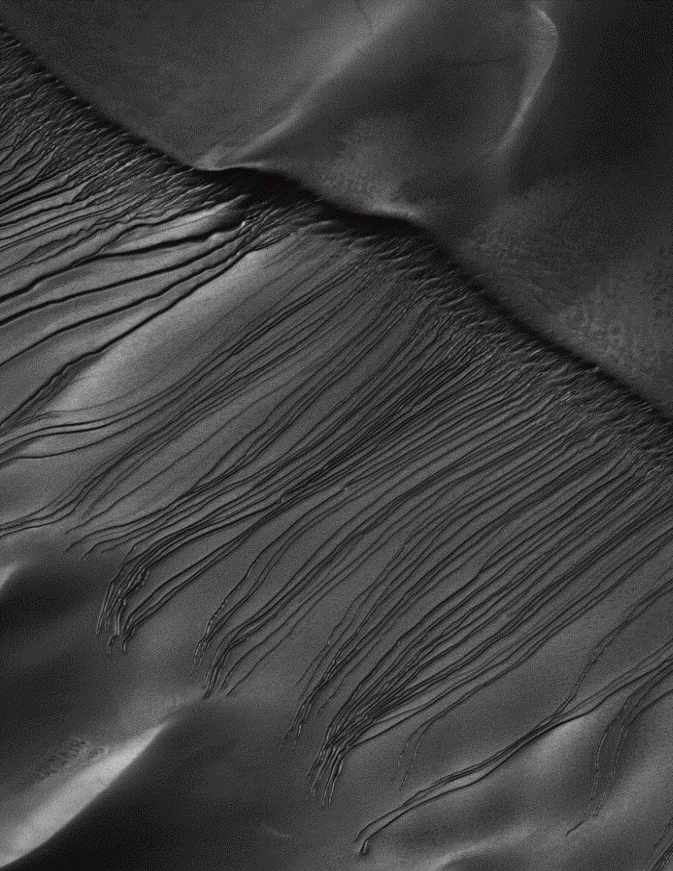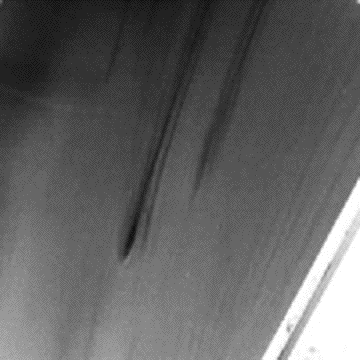
home •
about •
essential guide •
picture of the day •
thunderblogs •
news •
multimedia •
predictions •
products •
get involved •
contact
picture of the day archive subject index
The long filamentary channels seen here lie on a towering "sand dune" in the Martian Russell Crater. Though most NASA scientists see these channels as fluid-carved "gullies," investigators with the Malin Space Science Systems
say "Their origin is unknown, although it is known that they tend to occur only on slopes facing southward."
Credit: NASA/JPL/Malin Space Science Systems
Feb 06, 2008
The "Gullies" of Russell Crater on MarsA bizarre complex of channels, lying on the south-facing bank of a “sand dune” in Russell Crater on Mars, directs our attention to something planetary scientists have long ignored--pervasive electrical activity on the planet.
In recent years much evidence has accumulated to suggest that electrical events unknown to mainstream science are “business as usual” on Mars. We have recently discussed outbursts of massive dust storms mysteriously related to global warming on the planet. We have also cited “impossible” assemblies of tightly packed dust devils feeding the billowing clouds of regional storms.
In this TPOD series on Mars, we intend to show that present electrical activity on the planet is carving surface features of sufficient size to be seen from space. This activity, though incomprehensible in traditional geologic terms, is not just a further validation of the “Electric Universe”; it also offers new lines of evidence that can illuminate the earlier catastrophic history of the planet.
One of the mysteries to be solved lies about 55 degrees south, on an immense “sand dune” in Russell Crater. The channels are fresh and show virtually no deposition of circulating dust from the Martian atmosphere. They remain a mystery, so long as one applies conventional assumptions.
The first enigma presented by the ravines is the surreal appearance of the entire complex--an anomalous but repeated pattern. Numerous “tributary” networks, each a virtual copy of its neighbors, feed sharply defined channels running down the embankment. The bizarre repetition of a single pattern appears to defy all familiar erosional regimes. Fluid flow is typically subject to much more random tributary systems and irregular, non-systematic distribution.
In contrast to normal fluid flow, most of the ravines maintain a consistent width, then terminate abruptly, each traveling roughly the same distance as the others. Each gully presents levees that neither grow nor diminish along their path. No breach of ravine walls is evident. No indication of outflow, typical of liquid flowing down a steep incline, can be seen.
Unusual but recurring patterns standing side by side are a good indication that an unusual answer is called for. In this case, that means an answer outside the rules of random topography and fluid erosion. Recurring patterns are, as well demonstrated in decades of laboratory research, extremely common in plasma discharge behavior. And since plasma discharge appears to be directly involved in generating the dust storm and dust devil activity previously noted, it is certainly reasonable to ask whether these remarkable channels might also find an electrical explanation.
A fascinating counterpart to the Russell Crater gullies occurred in an experiment by Bill Beaty, a nationally distinguished and award-winning electronics hobbyist. He produced a trough in a layer of carbon dioxide “fog” by directing beams of protons at the layer from a human hair about 1/4 inch long. Below is a photo of one of the troughs, revealing a remarkable similarity to the enigmatic Martian ravines, including the “levees” and abrupt termination.
But why should we believe that something so far from conventional geologic references as beams of positively charged particles could be responsible for the channels under consideration? There are, in fact, dozens of reasons to consider this possibility--all interconnected and all pointing to something that NASA scientists have yet to take into account--a charged planet moving on a modestly elliptical orbit (significantly more elliptical than Earth’s) within the electric field of the Sun.
Planetary scientists do not understand why the highly filamentary channels of Russell Crater tend to lie on south-facing slopes of massive “dunes.” But this is actually another clue suggesting the electrical nature of the formations. Our data, the primary subject of this TPOD series, suggests that positively charged particles from the Sun are entering the Martian ionosphere and following magnetic field lines to the surface. (NASA scientists are finding that localized magnetic fields are much more prominent in the southern hemisphere than the northern hemisphere.) In the absence of a substantial insulating atmosphere, such ion or proton beams could indeed account for the troughs in the Russell Crater “dune” field.
As we have repeatedly emphasized, a new theory must be judged by its predictive power-- it’s ability to account for things left unexplained by prior theory and its record of success in anticipating discoveries that flatly contradict earlier assumptions or catch “official” science by surprise. Electrical theorists do not consider the standard descriptions of the Russell Crater “gullies” to be plausible. Rather, they have viewed these troughs as a “bundle of predictions” awaiting confirmation. Working from general to specific, the electrical interpretation suggests the following:
• Reliable explanations for atmospheric and geologic events on Mars will come from a practical understanding of electric discharge effects;
• Plasma discharge--from electrostatic sculpting, to particle beam effects and spark machining--is altering the surface of Mars year by year.
• The channels on Russell Crater dunes are not the result of flowing liquid;
• When viewed more closely no evidence of flowing liquid will be found;
• When viewed more closely it will be seen that the channels do not follow topography in the fashion of flowing liquid;
• Since the channels are carved into a smooth surface (i.e., a surface not strewn with boulders and rocky rubble), the immediate surroundings should have preserved more subtle evidence of particle beam activity, electrostatic sculpting, and glassification.
• Cratering in connection with channel formation must be anticipated, particularly at the starting points and terminations of the channels
• The events creating the troughs are almost certainly connected to other enigmatic events in the immediate vicinity and in the larger region of the southern hemisphere;
Our reading of the evidence is readily testable. If that reading is correct, then things happening today on the surface of Mars may well present one of the most promising breakthroughs for the Electric Universe hypothesis. What will happen to planetary science if principles virtually ignored for a century or more emerge as inescapable fact?__________________________________________________________________________
Please visit our new "Thunderblog" page
Through the initiative of managing editor Dave Smith, we’ve begun the launch of a new
page called Thunderblog. Timely presentations of fact and opinion, with emphasis on
new discoveries and the explanatory power of the Electric Universe."The Electric Sky and The Electric Universe available now!

|
|

|
EXECUTIVE EDITORS:
David Talbott, Wallace Thornhill
MANAGING EDITORS:
Steve Smith, Mel Acheson
CONTRIBUTING EDITORS: Michael Armstrong, Dwardu Cardona,
Ev Cochrane,
C.J. Ransom, Don Scott, Rens van der Sluijs, Ian Tresman
WEBMASTER: Brian Talbott
Copyright 2007: thunderbolts.info
![]()
home •
thunderblogs •
forum •
picture of the day •
resources •
team •
updates •
contact us


